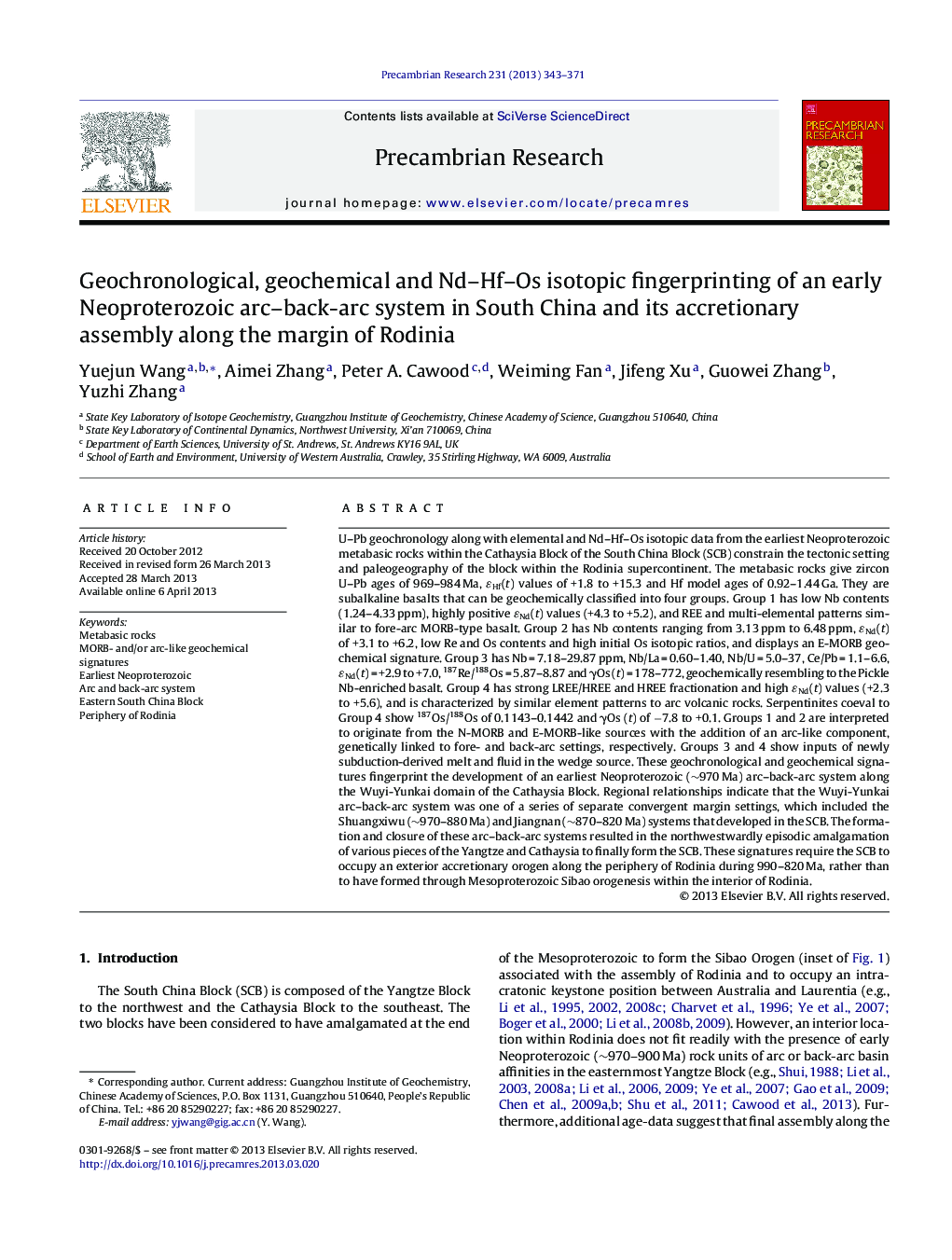| کد مقاله | کد نشریه | سال انتشار | مقاله انگلیسی | نسخه تمام متن |
|---|---|---|---|---|
| 4723225 | 1639643 | 2013 | 29 صفحه PDF | دانلود رایگان |

• The metabasic rocks in Cathaysia yield U–Pb ages of 969–984 Ma and TDM(Hf) of 0.92–1.44 Ga.
• They originated from a subduction-modified MORB-like source linked to an arc–back-arc setting.
• The South China Block was created by episodic amalgamation of a series of arc fragments between ∼970 and 820 Ma.
• The South China Block is an exterior accretionary orogen along the periphery of Rodinia rather than in the interior.
U–Pb geochronology along with elemental and Nd–Hf–Os isotopic data from the earliest Neoproterozoic metabasic rocks within the Cathaysia Block of the South China Block (SCB) constrain the tectonic setting and paleogeography of the block within the Rodinia supercontinent. The metabasic rocks give zircon U–Pb ages of 969–984 Ma, ɛHf(t) values of +1.8 to +15.3 and Hf model ages of 0.92–1.44 Ga. They are subalkaline basalts that can be geochemically classified into four groups. Group 1 has low Nb contents (1.24–4.33 ppm), highly positive ɛNd(t) values (+4.3 to +5.2), and REE and multi-elemental patterns similar to fore-arc MORB-type basalt. Group 2 has Nb contents ranging from 3.13 ppm to 6.48 ppm, ɛNd(t) of +3.1 to +6.2, low Re and Os contents and high initial Os isotopic ratios, and displays an E-MORB geochemical signature. Group 3 has Nb = 7.18–29.87 ppm, Nb/La = 0.60–1.40, Nb/U = 5.0–37, Ce/Pb = 1.1–6.6, ɛNd(t) = +2.9 to +7.0, 187Re/188Os = 5.87–8.87 and γOs (t) = 178–772, geochemically resembling to the Pickle Nb-enriched basalt. Group 4 has strong LREE/HREE and HREE fractionation and high ɛNd(t) values (+2.3 to +5.6), and is characterized by similar element patterns to arc volcanic rocks. Serpentinites coeval to Group 4 show 187Os/188Os of 0.1143–0.1442 and γOs (t) of −7.8 to +0.1. Groups 1 and 2 are interpreted to originate from the N-MORB and E-MORB-like sources with the addition of an arc-like component, genetically linked to fore- and back-arc settings, respectively. Groups 3 and 4 show inputs of newly subduction-derived melt and fluid in the wedge source. These geochronological and geochemical signatures fingerprint the development of an earliest Neoproterozoic (∼970 Ma) arc–back-arc system along the Wuyi-Yunkai domain of the Cathaysia Block. Regional relationships indicate that the Wuyi-Yunkai arc–back-arc system was one of a series of separate convergent margin settings, which included the Shuangxiwu (∼970–880 Ma) and Jiangnan (∼870–820 Ma) systems that developed in the SCB. The formation and closure of these arc–back-arc systems resulted in the northwestwardly episodic amalgamation of various pieces of the Yangtze and Cathaysia to finally form the SCB. These signatures require the SCB to occupy an exterior accretionary orogen along the periphery of Rodinia during 990–820 Ma, rather than to have formed through Mesoproterozoic Sibao orogenesis within the interior of Rodinia.
Journal: Precambrian Research - Volume 231, July 2013, Pages 343–371